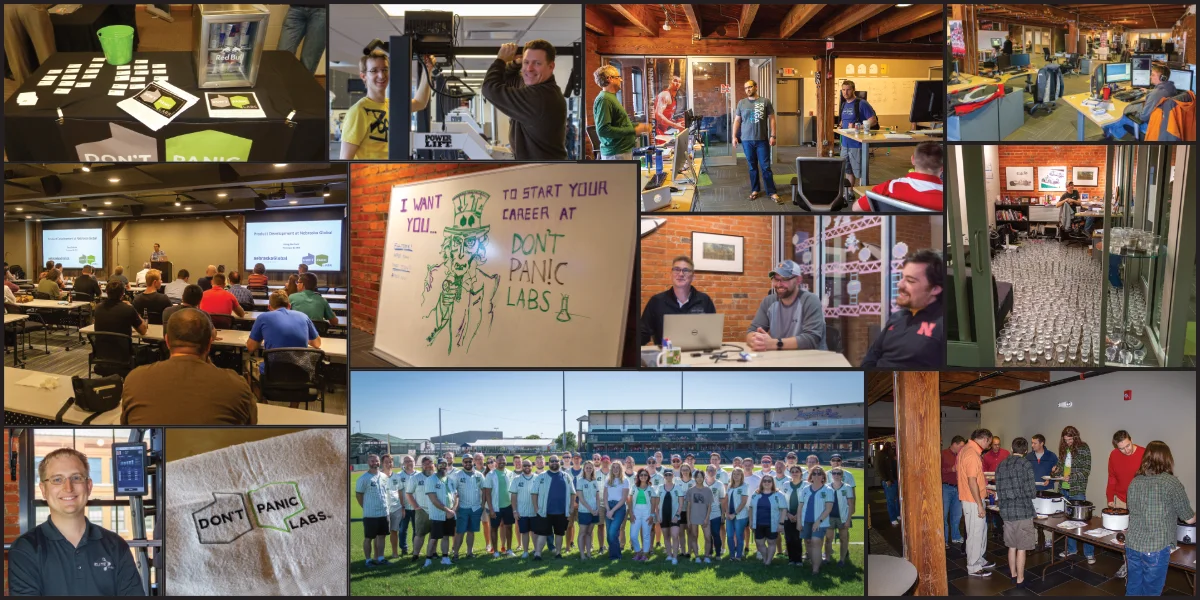
Don’t Panic Labs – The First 15 Years
April 2025 marks the 15th anniversary of the founding of Don’t Panic Labs. We are a software product development and innovation company in Nebraska that focuses on providing the necessary support, experience, and product development capacity to innovation groups and entrepreneurs to bring their innovative vision to life.
In this blog post, I will be reflecting on the 15-year journey we have been on and will share some stats on the impact we have had in our region, as well as how we have grown and evolved to meet the needs of our clients. I will finish with a look at what the future holds.
Early Beginnings
Don’t Panic Labs was born 15 years ago this April out of the vision for Nebraska Global that Steve Kiene and I began discussing and brainstorming back in 2009. The vision for Nebraska Global was to combine “nerds and money” to help bootstrap a technology startup ecosystem in Nebraska.
We were just coming out of the housing crisis of 2007-2008 and the Great Recession that followed. Our motivation was to give a boost to economic development in Nebraska by demonstrating that innovation and new software technology companies can be born right here in Nebraska and not just in California, Boston, New York, and Austin.
Our unique approach was to raise a capital fund and then manage the investment of those dollars into new software tech companies that would be built and managed by members of the Nebraska Global team. We would do this very publicly (to increase awareness), and we would heavily leverage interns and local hires to help provide the confidence that we have the local talent to be successful. Don’t Panic Labs became the identity of the product development arm of Nebraska Global.
Our intent was never to try and create massively scaled companies like Uber and others but to focus on the types of companies and technologies that we felt could realistically evolve out of our state – pursuing singles and doubles instead of home runs. Our experience had always been enterprise products sold or licensed to companies (healthcare information systems, developer tools, ecommerce).
We began brainstorming ideas of our own while entertaining ideas from people in the community. We pursued some product ideas that did not end up with a product-market fit (CRM implementation tooling, decedent debt collection), along with a few other ideas that became viable companies:
EliteForm is a performance measuring company we launched that uses patented computer vision technology to track velocity and repetitions as athletes perform various strength exercises. It has become the industry leader in this space and is in use by high school, collegiate, and professional sports teams as well as US military units.
Beehive is a versatile cloud-based asset management and utility billing platform that is used by small and medium-sized cities across the US to manage public infrastructure and assets as well as enable public works departments to manage utility billing. Beehive was recently acquired by CivicPlus to enable them to offer a comprehensive suite of products for their city customers.
Ocuvera is another computer-vision technology company focused on patient safety within medical settings. The idea behind this company was to take what we learned in developing EliteForm and apply it to solving a major issue within hospitals and care facilities – patient falls. The result was a patented technology that can autonomously watch patients in a hospital room and predict when they will attempt to get out of a bed or a chair without assistance, thereby increasing the risk of a fall. With Ocuvera’s technology, caregivers have ample time to respond to the patient’s room to provide assistance before the patient has left their bed or chair. Use of this technology has been shown to dramatically reduce the risk of falls with high-risk patients.
The focus of Don’t Panic Labs during the first five years was to support the development and evolution of these portfolio companies to get them to sustainability. As 2014 rolled around, we found ourselves with EliteForm and Beehive continuing to gain some momentum but with less need for a large development team footprint once the products transitioned from rapid development of the initial versions of the products to incremental updates and evolution. We also were reaching the end of the “investment” phase of Nebraska Global as we had our hands full with ensuring the success of the existing products. As a result, we began to explore other ways for us to leverage the 15 or so development resources that were not dedicated to the portfolio companies.
Growth and Expansion
In 2013 and 2014, we began exploring other ways we could leverage our software development talent to help enable innovation within Nebraska. Two opportunities that presented themselves gave us a chance to explore possibilities that would lead to establishing Don’t Panic Labs as a standalone company.
In 2013, we began a joint venture with National Research Corporation to develop a new product in a related area to their core healthcare metrics business. This was a unique opportunity for us where we combined their domain experts and sales staff with a dedicated Don’t Panic Labs development team to form a separate company called NRC Connect. This company was co-located with the other Nebraska Global portfolio companies, which enabled them to be surrounded by other startups and experienced innovation talent. In 2015, NRC acquired Nebraska Global’s interest in the company and transitioned it back into NRC proper.
Also in 2013, we began entertaining requests from local companies like Assurity and Nelnet to provide product development assistance with some of their innovation projects. At first, we hesitated to use Don’t Panic Labs as a professional services organization, but then we realized that our ability to share what we have learned to help foster innovation could be enhanced by helping other organizations within Nebraska.
By 2014, we had decided to structure Don’t Panic Labs as a standalone company alongside the other portfolio companies. The business model for this “new” company was to provide professional software development services to lead the development of innovative products for companies and startups in the Nebraska region. Along the way, we would look for strategic opportunities to make investments in some of these products following the model we used with NRC Connect.
In 2022, we took a huge step by agreeing to terms that would allow employees at Don’t Panic Labs to buy out Nebraska Global’s interest in the company. Doing this gave us the ability to provide significant “skin in the game” for the employees as we looked to grow and expand our business and services.
Since the launch of Don’t Panic Labs as a company in 2014, we have continued to expand the services and capacity of the organization from a single business development leader and a handful of engineers in 2014 to a company of 55 people today that includes a variety of specialized roles and skills in business development, product management, interaction design, testing, architecture, project integration, and technical leadership that can now not only develop a new product for our customers but, maybe more importantly, can help lead them through the initial process of determining whether their idea is viable, desirable, and feasible before they are spending a lot of money building the product.
Innovation Impact
In the last 10 years, Don’t Panic Labs has gone from being a playful identity for an internal product development team to an organization that is well-known in the region and possibly the largest professional services company of our kind within Nebraska. Our success has been the result of a lot of hard work by the dedicated employees of this company who have lived our core values daily:
- Empathize then own it
- Build smart
- Deliver with pride
- Be the change you seek
Our growth is a direct result of the referrals by existing customers and the clear demand for our skills and experience by entrepreneurs and innovators in our area. I, for one, feel an enormous amount of responsibility to our fellow Nebraskans to help ensure that we are there to help them bring their innovative ideas to life. I am confident our employees feel this same responsibility.
Doing a retrospective like this causes one to reflect on the impact of our efforts. The easiest way to start such a reflection is to look at some numbers that reflect this impact. The following is a list of interesting statistics that we pulled together as part of our 15-year celebration:
- Nearly 200 companies have collaborated with us over the past 15 years
- About a third of those were startups
- We helped bring more than 200 products to life
- Our reach has extended across nearly 20 states and provinces
Many of these products were incredibly ambitious, with complex business and technical problems that represented significant innovation efforts for both our partner and Don’t Panic Labs. To increase the chances of success, we needed to develop a holistic approach with deep innovation, technical, and interpersonal expertise that could work for everyone, from solo entrepreneurs to publicly traded companies re-inventing their core platforms.
The sheer number of engagements allowed us to hone a design thinking and co-creation approach to understand the nature of the problems or opportunities, divergently generate possibilities, and converge on novel solutions to move ideas forward. We’ve developed deep technical competencies involving artificial intelligence, the Internet of Things (IoT), distributed systems, sentiment analysis, user experience design, multi-platform mobile applications, embedded systems, cloud architectures, and HIPAA/CJIS/SOC and other regulatory compliance. In many cases, we included our partners’ existing development teams to simultaneously modernize their processes and skills while also ensuring a successful transition.
We have had the opportunity to apply our skills and approach across a wide range of problems and business domains. Examples include high-rise water leak detection and shut-off, legal contingency fee calculation, ankle scanning for brace manufacturing, real-time collaboration between oral surgeons, dentists, and dental implant manufacturers, corporate culture training, corporate wellness, grain dryer statistics and control, point of sale and franchise management, freight transportation and logistics management, real-time performance statistics of ATV racing, auction listing management, career discovery through social media and collaboration between employers and educators, organic food certification management, and social media monitoring and safety for youth.
Community Engagement
From the very beginning of Nebraska Global and Don’t Panic Labs, we intended to be an agent of change within our community to influence how we approached software development as well as how we educated people who were pursuing a career in software. This effort has taken many forms, and we continue to evolve our approach to both scale our efforts and maintain a focus on our local communities.
We have been a constant fixture at local and regional developer conferences, with many of our folks devoting significant time and energy to developing and delivering conference sessions and workshops. I myself have delivered over 50 presentations (conference sessions, keynotes, user group talks) in that time frame.
Influencing the way we train software engineers has been a consistent focus of mine since we formed Nebraska Global. A number of us have assisted our local universities and colleges by providing guest lectures, coaching student innovation teams serving on advisory boards, and even taking on the responsibility of teaching entire courses.
Since 2010, we have hosted over 100 summer and in-term internships for university students and some high school students. There was no way we would have been able to hire all of these students (although we did hire some of them). We took on these students as part of our mission to both help them realize the opportunities that existed in Nebraska as well as give them a better understanding of what it really means to be a software engineer.
In 2020, we helped launch the Aksarben Foundation’s Nebraska Tech Collaborative (NTC) workforce initiative, which is focused on attracting, developing, and retaining tech talent and entrepreneurs. One of the more significant achievements of this effort has been the establishment of the requirement that all Nebraska high school students take a computer science course in order to graduate, making us one of the few states in the country with such a requirement. NTC’s mission is very aligned with our own, and we continue to be active in leading and supporting NTC’s initiatives as well as serving on the executive committee.
Also in 2020, we launched our Pathways program with our education partner, Doane University. This novel education program combines the computer science curriculum of Doane with the software engineering curriculum of Don’t Panic Labs to transition people already in the workforce into skilled junior software developers. To date, we have graduated 55 individuals from this program, some of whom are now software developers at Don’t Panic Labs.
We have always felt that in-person collaboration was the most effective way to problem-solve and be our most productive. This includes the collaborations we are having with our entrepreneur clients. When feasible, we have made room in our own office space to allow these early-stage companies to have a home base to operate from even beyond the period of time when our development team was actively working with them. We look forward to expanding this service in our new office space in the Telegraph District.
The other exciting thing about our new office space is that we have specifically designed the layout to allow us to once again host larger user groups and other community activities. Follow us on LinkedIn to learn when these events will be happening.
Challenges and Lessons Learned
As with any startup, our journey over the last 15 years has been filled with challenges and lessons learned. I suppose “lessons learned” is probably too “academic” to describe the experience. I have often shared with the company the pros and cons of working at a small company vs a large company (I worked at McDonnell Douglas for six years). One of the key points I make to them is that we have the autonomy to do things the way we want and pursue opportunities that present themselves while answering to no one but ourselves.
For me, this is incredibly liberating and is what has made Don’t Panic Labs the ideal (and final) stop in my career. When I think back to where we were starting out in 2010 to where we are today, and where we are headed, I see a consistent pattern of a company led by passionate, driven people who are constantly looking for ways to improve our company, our culture, our products and services, and our approach to solving problems. The one constant over these years has been change. Recognition of this is the reason we amended our core values four years ago to include “Be the Change You Seek.”
Walking you through the evolution of our company would dramatically lengthen an already lengthy blog post, so I will focus here on a few highlights that will hopefully give you a sense of how the company has approached challenges and evolved.
Expanding Our Services to Meet the Needs of Innovators
In the beginning (back in 2010), our focus was building a software development team that was flexible and able to be moved around to different projects without friction. As we started providing development services for innovation teams and startups, we began to understand that many of these teams needed help beyond the design and development of their software systems.
We realized that our experience building the Nebraska Global portfolio companies and our work with these innovation teams and startups put us in a unique position to develop and expand our professional services by providing coaching and support for these entrepreneurs before deciding to build a product, during the product development, and as they attempt to “cross the chasm” to viability.
Growing in Size
When we spun out Don’t Panic Labs into its own company in 2014, I (foolishly) began to provide my thoughts to the team on how big the company could get. Given the demand I anticipated, I honestly thought the company would eventually grow to maybe 20 people. It became clear in a few years that my ability to predict the demand proved short-sighted. As our customer base grew and we became well-known in our region, the size of the company continued to grow at a fairly linear pace to where we are today – more than twice the size of my early predictions.
This growth, while a positive indicator, created some challenges for us from an operational standpoint. Despite my military background, I prefer a management and organizational style that values consensus building and flat organizational structures. As we continued to grow, the lack of an organizational structure proved untenable. We decided to implement EOS and Traction which allowed us to create the necessary hierarchy structure and processes to effectively manage this growth. It is one of the smartest things we ever did.
We also realized that we needed support staff to help with employee growth and development, create the necessary human resource processes, and abandon our more ad hoc approaches to this part of the company.
The Pandemic
Obviously, the pandemic was incredibly disruptive to us, no different than anyone else. I can still remember standing up in front of our employees in early March 2020 and telling them I was not sure what would happen but that we would all work from home starting immediately. Our adoption of Office 365 and the cloud-based collaboration tools made this transition seamless.
Our number one objective was to preserve the company while avoiding having to reduce staff. I once experienced an interesting process at a company once where they did not lay off manufacturing people during cyclical downturns but instead reduced everyone’s hours to enable them to keep these people employed while they waited for the business to rebound. I pitched a similar approach to the employees at Don’t Panic Labs as a possibility should we need to do something to keep our heads above water during this time. Fortunately, the federal Paycheck Protection Program (PPP) was passed, and the folks at Union Bank & Trust did an incredible job helping us through this process.
In the end, we did lose some folks during the pandemic who felt they needed to make a change for one reason or another. Still, we were able to generate just enough business to combine with the PPP money to keep the company afloat until the business again picked up in 2021.
Office Space That Worked
Back in 2010, we felt we needed office space that was an open floor plan to enable the flexibility of re-arranging desks to combine developers into teams as necessary. This was an extreme reaction to my previous experience where everyone was in separate offices. While I think the open floor plan was good for collaboration and ad hoc conversations, it was not so good for when people needed to isolate themselves and focus on their tasks at hand. The tension between these two needs is something we continue to work through.
When we moved into our current space in the Telegraph District, we spent a lot of time in focus groups, surveys, design sessions, and walk-throughs to come up with a layout that addresses these two tensions but also accommodates the need for customer meeting spaces, business development, community gatherings, water-cooler collisions, and employee social activities. While we are not sure we have completely solved this problem, what I am certain of is that we will be very thoughtful and collaborative in determining any future changes we make.
Leaving Nothing to Chance
In many ways, Don’t Panic Labs has been a personal laboratory for understanding what it really means to develop software as an engineering discipline. Technical excellence has always been a hallmark of our companies for the last 25 years, but I have never felt like we have truly “arrived.” The journey has felt more important than the goal of reaching any form of destination. I still feel that we, both Don’t Panic Labs and our industry, have a long way to go before we can say we are truly engineering software.
One of the epiphanies I had a few years back is that many, if not all, issues that develop during a software development project are not the result of malicious intent, laziness, or lack of attention or focus but rather the result of errors in judgment. It is natural as we grow in our skills and experience to have fewer errors in judgment, but that does not seem like a very efficient way to deal with this phenomenon. The good news for us is that our recognition of this has enabled us to focus our efforts around reducing these errors in judgment.
For me, software engineering is about the knowledge, tools, processes, models, and methods that reduce the likelihood of these errors in judgment. Our focus in recent years has been 1) determine how to identify skills gaps through assessment, 2) identify areas within our knowledge, skills, and processes that can be improved to help identify and reduce errors in judgment, and 3) create educational assets and programs to help with the individual growth and development. We have leveraged these efforts to both improve our own skills and outcomes as well as make them available to the development community to help level-up their own teams.
Looking Ahead
The advancements in technology over the last 15 years have been breathtaking, and new technologies in our hands now and on the horizon appear to be destined to have a significant impact on our industry both in the skills that will be required as well as the types of problems we will be addressing. I am optimistic that Don’t Panic Labs will lead the effort to leverage these new advances, create a positive impact on our communities, and improve the lives of people everywhere by enabling innovators to solve problems we hadn’t imagined were solvable.
Nebraska has come a long way since ranking 52nd out of 50 states (behind D.C. and Puerto Rico) in venture investment and startups in the late ’00s. Fostering innovation and startup activity in Nebraska has certainly been a team effort between business leaders, investors, and state and local government.
I like to think that the vision for Nebraska Global and the focus and drive of the folks at Don’t Panic Labs has played a significant role in creating a thriving tech ecosystem in our state. It is my hope that everyone at Don’t Panic Labs feels some pride in their contributions, as well as the responsibility to continue to bring every innovator’s vision to life.
I look forward to seeing the impact we will have in the next five, ten, and 15 years.



